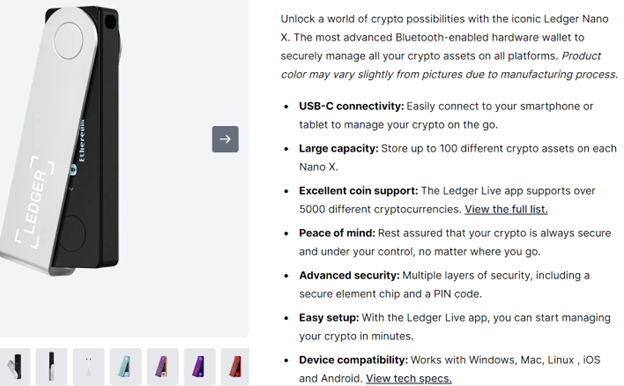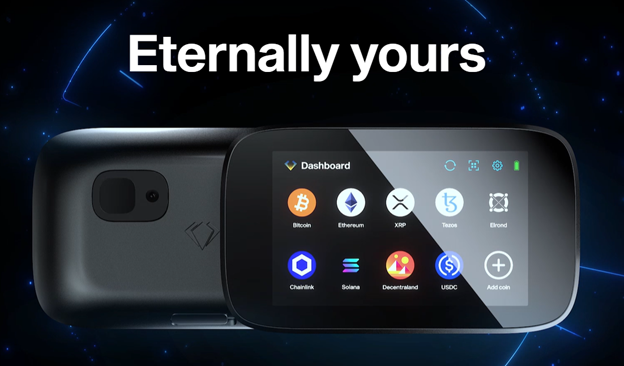 |
| By Beth Canova |
If you’ve spent any time at all on crypto message boards or Twitter threads, you’ll likely have heard the phrase “not your keys, not your crypto.”
It’s a rallying cry among crypto enthusiasts. One that reminds us of the trustless nature of crypto.
That’s because crypto empowers average users like you and me to be our own banks and brokers … rather than trusting a third party with our assets.
There are two main ways you can store your crypto.
- A software wallet that guarantees you — and only you — are in total control of your crypto and your financial destiny while remaining connected to the internet.
- A hardware wallet, which is disconnected from the internet and ideal for long-term, secure crypto storage.
A software wallet is handy for traders or those looking to connect to DeFi applications, like lending platforms.
But because they are still connected to the internet, they are vulnerable to hacks or attacks that could cost you a pretty Satoshi.
That’s why long-term investors typically keep their crypto in a hardware wallet. Disconnected from the internet, your crypto and private keys remain out of reach of those bad actors.
As the name suggests, hardware wallets are physical devices that can be used to store your crypto keys offline. They typically look like small USB drives.
In our opinion, hardware wallets are the safest way to store your crypto.
But that doesn’t mean they’re perfect either.
Hardware wallets can be expensive, costing anywhere from $50 to $500. They are also less convenient to use and less user friendly than software wallets.
These hurdles have made hardware wallets unpopular with newer crypto users.
Still, for investors who plan on holding for a while — affectionately called HODLing in crypto — the cost and minor inconvenience are small prices to pay for the additional security and stability.
There are a few options for hard wallets available. Below are three of the most popular options among the crypto crowd:
This top-of-the-line hardware wallet retails for $129 at the time of writing. And it supports over 1,000 crypto assets, which is impressive.

Even more so is its dedication to security. Trezor has been audited by third-party security researchers and boasts a long-standing, successful track record.
Since its initial release, there have been no known instances of successful remote hacks resulting in loss of user funds to date.
As such, Trezor is widely considered the safest crypto wallet on the market.
The Trezor Model T wallet can also be integrated with some soft wallets, combining the security of the former with the convenience of the latter.
However, our team did note that Trezor’s user interface is not as easy to navigate for new users as its competitors’.
Based in France, Ledger is considered the standard in the hard-wallet market. It has a few options, including the beginner-friendly Ledger Nano S (for $80) and the more sophisticated Ledger Nano X (for $150).
The Nano X has Bluetooth capabilities to allow for cordless connection to your laptop, supports over 5,500 different cryptocurrencies and features a CC EAL5+ Certified secure element chip.

Both devices can run on most major operating systems and can utilize the Ledger Live software. This means users to manage their coins on desktop or mobile for on-the-go transactions. All while keeping your private keys offline!
Since your keys can’t be accessed from your computer or mobile, this method is more secure than simply using a software wallet.
And, like Trezor, both Ledger Nanos also support integration with web3 wallets such as MetaMask, so users can access various DeFi platforms.
There has, however, been some controversy around Ledger.
In 2023, the Ledger team proposed an ID-based key recovery service. Users' seed phrases would be backed up in a centralized location. If you forgot your seed phrase, you would need to provide a passport or national identity card to confirm your identity in order to retrieve your backed-up seed phrase.
The choice to forgo anonymity and decentralization was not well received. Ledger did eventually walk this plan back. But for many, the suggestion alone was enough to make them think Ledger wasn’t taking security seriously.
If you’re looking for maximum security to HODL, then you may want to consider NGrave Zero.

It is 100% disconnected from the internet, unlike the other two hard wallets I’ve covered. And it has the highest security certification standard possible — higher than Ledger’s — and has the same third-party security certifications as Trezor.
Basically, NGrave Zero reaches a higher standard of security than any of its competition.
The device itself also has a light sensor, biometric scanners, pin protection and is tamperproof for maximum security.
And it is user friendly, with a large screen and simple navigation — something that has been a sticking point with other hard wallets, as user interfaces were not easy to navigate.
The downside to all this security is that NGrave Zero doesn’t have web3 integration that would allow it to interact with a soft wallet. This means if you want to use your crypto, you’d have to move it out of your hard wallet entirely.
It is also the most expensive of our top three wallets, coming in at $500.
Final Considerations
The simplest and most convenient way to hold crypto is on a centralized exchange.
But that’s simply not as safe as you may think.
Just recently, we saw an attack on the centralized exchange ByBit. This one was next level — with well-trained hackers injecting malicious code directly into the user interface to steal $1.4 billion in assets.
We don’t want you to be in that position. Ever.
A centralized exchange may be a perfectly fine route to take if you have a relatively small portfolio of cryptos, particularly if you plan on trading them frequently or are a day trader.
But if you’re willing to put in a bit more legwork — or sacrifice a tiny bit of convenience — it would be far more secure to use your own soft wallet.
Meanwhile, for crypto you plan on holding for a long time or crypto you have in large amounts, there’s simply no substitute for a hard wallet.
After all, if you’re holding a lot of crypto assets, you definitely want to make sure they receive the best protection possible.
It’s up to you to decide if the more complicated process of a hard wallet is worth it for you. And if so, which wallet best suits your needs.
Yes, it’s more secure, but if you’re constantly trading or investing only small amounts, the added security may not be worth the effort.
Here’s a tip from your Weiss Crypto experts: A solid approach, in our opinion, is to use a combination of different wallets. That way, you can tailor each one to a particular asset, purpose or intended holding time.
It’s incredibly easy to use a soft wallet in combination with a hard wallet — especially ones that feature web3 integration — for the best of both worlds.
Either way, you’ve taken a massive step in keeping your crypto safe.
Best,
Beth Canova
Crypto Managing Editor

